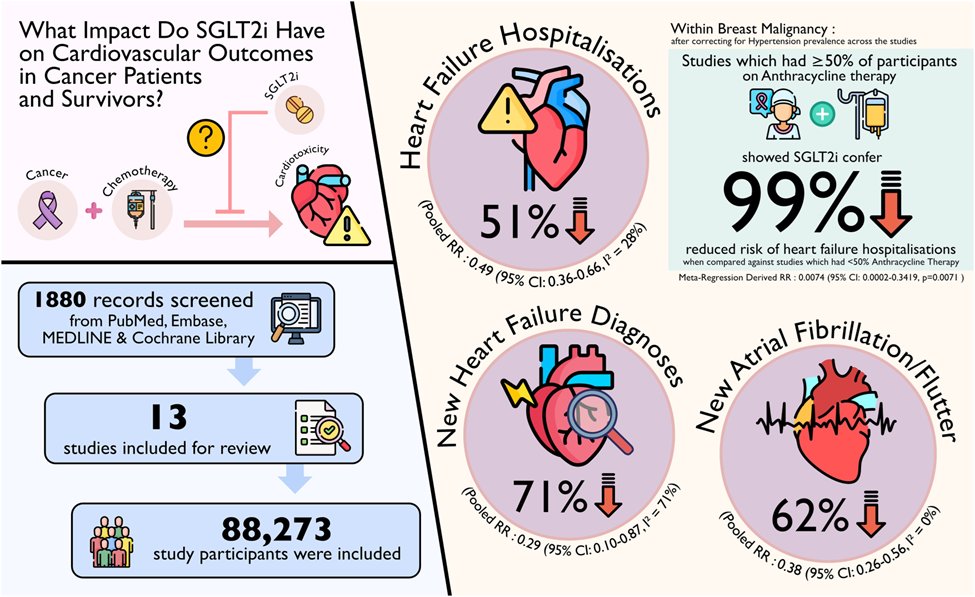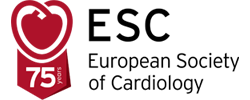reviewed by Giuseppe Biondi Zoccai
As global cancer survival rates improve, attention is increasingly moving toward managing the long-term side effects of cancer treatment. Chief among these cardiovascular complications is heart failure (HF), often driven by the cardiotoxic effects of chemotherapy agents such as anthracyclines, other chemotherapeutic treatments and even cancer itself. These complications are not merely incidental; they are now a leading cause of non-cancer mortality and morbidity in cancer patients and survivors [1].
In this context, a recent systematic review and meta-analysis by Bhalraam et al., published in the European Journal of Preventive Cardiology [2], marks a major milestone in cardio-oncology.
The study explored whether sodium–glucose cotransporter-2 inhibitors (SGLT2i), a drug class originally developed to manage type 2 diabetes, but which subsequently found great use in patients with HF, might also protect heart function in cancer patients undergoing chemotherapy, leading to a reduction in heart failure incidence, hospitalisation and mortality.
From Diabetes to Cardio-Oncology
SGLT2 inhibitors, such as dapagliflozin and empagliflozin, have previously shown clinical reductions in HF hospitalisations and all-cause mortality, even in patients without diabetes [3,4]. Their benefits are thought to stem from favourable hemodynamic and metabolic effects, such as decreased cardiac preload and afterload, improved myocardial energy efficiency and even reduced systemic inflammation [5].
Bhalraam et al. aggregated data from 13 observational studies, including 88,273 cancer patients and survivors. The meta-analysis found that SGLT2i use was associated with:
- A 51% reduction in HF hospitalisations (relative risk [RR] 0.49)
- A 71% reduction in new-onset HF (RR 0.29)
- A 55% reduction in all-cause mortality (RR 0.45)
These are not marginal effects (see figure 1). The number needed to treat (NNT) to prevent one death was just four, which is impressive although the retrospective nature of the studies included is open to bias [2].

Figure 1 summarises the paper’s key outcomes. Reproduced with permission from [2].
Anthracyclines and Breast Cancer: A Striking Synergy
Perhaps the most compelling aspect of the analysis is the striking benefit observed in breast cancer patients treated with anthracyclines. In studies where at least half of patients were on anthracyclines—a chemotherapy class known for dose-dependent cardiac toxicity—the risk of HF hospitalisation was reduced by an astonishing 99% among those taking SGLT2i (RR 0.0085) [2].
This finding opens a new door for mitigating cancer therapy-related cardiac dysfunction (CTRCD), especially when curbing or discontinuing chemotherapy to avoid cardiac damage is not an option. While traditional cardioprotective strategies such as beta-blockers and ACE inhibitors have shown variable success, SGLT2i may offer a novel, well-tolerated alternative [6].
Real-World Evidence Meets Clinical Urgency
Importantly, the meta-analysis drew from real-world observational data, which—though limited by potential confounders—better reflects the diversity and complexity of patients seen in everyday oncology practice. While no randomized controlled trials (RCTs) were included, the consistency of the findings across multiple large cohorts adds to the weight of the evidence.
Moreover, the observed benefits extended across several types of cancer and chemotherapy regimens, including gastrointestinal, hematologic, and genitourinary cancers. That said, the magnitude of effect was most pronounced in populations exposed to known cardiotoxic agents, further supporting the rationale for targeted SGLT2i use in high-risk subgroups.
A Path Forward: Research, Guidelines and Integration
What does this mean for clinical practice? While we are not yet at a point where guidelines can recommend SGLT2 inhibitors as standard cardio-oncology prophylaxis, the groundwork has clearly been laid. These findings should catalyse well-powered RCTs to evaluate the timing, safety and efficacy of SGLT2i in cancer patients, especially those receiving anthracyclines or other high-risk regimens.
The study also highlights the need for a multidisciplinary approach. Collaboration between oncologists, cardiologists and primary care providers will be essential in identifying patients at risk, initiating early prevention strategies and monitoring long-term cardiovascular outcomes.
Conclusion
The findings of Bhalraam et al. point to a promising new role for SGLT2 inhibitors in oncology, not merely as metabolic agents, but as cardiovascular guardians for patients facing the dual burden of cancer and its treatment. This represents a turning point in Cardio-Oncology and these drugs could soon form a central pillar in the preventive cardio-oncology toolkit.
If validated in future trials, SGLT2i could enable oncologists to push the boundaries of chemotherapy dosing without compromising cardiac safety; a shift that would benefit not only survival statistics but the quality of survivorship itself.
In the evolving narrative of cancer care, it is time to write a new chapter, one where protecting the heart is as critical as treating the cancer.


 Our mission: To reduce the burden of cardiovascular disease.
Our mission: To reduce the burden of cardiovascular disease.